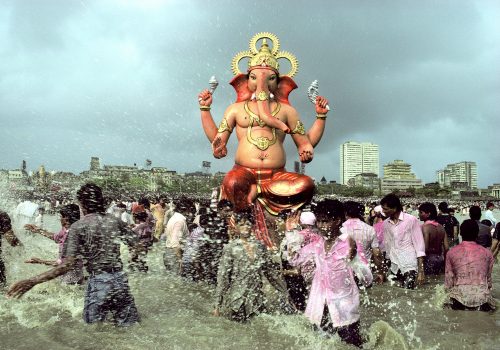Although he lived in Hong Kong, Paris, London and spent significant time in New York throughout his career, Raghubir Singh (1942-1999) dedicated his career to photographing his native India. Singh worked at the intersection of western modernism and traditional South Asian perspectives. He was influenced by the work of Henri Cartier-Bresson, whom he met in Jaipur in 1966, befriended William Gedney to whom he dedicated his second book on Calcutta (a small exhibition of Gedney’s work in India will accompany the exhibition), and traveled and photographed with Lee Friedlander. He pioneered color photography at a time when it was unpopular in the west, using it to great advantage to show the vibrant intensity of the country’s culture, traditions, and religion. Today Singh’s portrait of India during pivotal decades of social and political change is considered unique and unmatched.
Pulsating with dramatic compositions and his characteristically controlled use of color, Bombay, a series of street photographs on view at Howard Greenberg Gallery in New York, focuses on one of the artist’s most significant body of work. Made in the early 1990s, it led to his book Bombay: Gateway of India (Aperture, 1994). The exhibition coincides with a retrospective at the Met Breuer entitled Modernism on the Ganges: Raghubir Singh Photographs from October 11, 2017 – January 2, 2018.
Singh photographed the city of Bombay at a transitional point for the Indian economy. Bombay, the country’s economic capital stood as the metaphor for the broader changes that had begun across the country. Singh’s use of reflections are a revealing expression of this change. In the conversation that opens his book on Bombay, he told the British writer V.S. Naipaul, an admirer of his work, about the element of ambiguity and the sense of movement that glass and mirrors provide in his Bombay work. As Naipaul said, “You cannot take it all in at once. You have to let your eye move from center to center, so there is constant movement in the picture. I find this quality in your work. It is one of its virtues. The other thing I thought is that, with pictures like these one almost doesn’t need words.”
Mia Fineman, associate curator, Metropolitan Museum of Art, wrote in her text for the exhibition catalogue, “Singh’s Bombay street scenes are filled with a new kind of energy, as if the elements in the pictures are held in suspension by centrifugal force. Hands, gestures, and gazes swirl around a still center point, usually anchored by an individual who pointedly ignores the camera or stares back at it with confrontational directness.”
At the Howard Greenberg Gallery stand 27 images that expose the complexities of the city, moving from unvarnished scenes of poverty to utter opulence. Using a handheld camera with color slide film, he wandered through the city of Bombay recording often intimate moments: a father in bed holding up his infant son, a man deep in thought next to another man sleeping on a doorstep, a pensive teenage girl looking at the camera. Other images focus on Indian cultural traditions. Two men, revelers in the Holi festival of colors are splattered with purple pigment in a 1990 photograph. The festival celebrates the arrival of spring and participants are frequently drenched in pigment powder. Another festival, Ganesh Chaturthi, takes place towards the end of the monsoon season when Ganesh, the elephant-headed deity, is celebrated and immersed in the Arabian Sea. Singh’s 1989 photograph depicts a celebration with the enormous effigy of the deity.
Raghubir Singh, Bombay
October 26 – December 9, 2017
Howard Greenberg Gallery
41 E 57th St
New York, NY 10022
USA
















